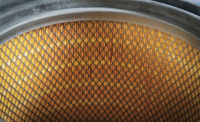EAST RUTHERFORD, NJ — The flash fire that burned seven workers, one seriously, at a U.S. Ink plant in New Jersey in 2012 resulted from the accumulation of combustible dust inside a poorly designed dust collection system that had been put into operation only four days before the accident, an investigation by the U.S. Chemical Safety Board (CSB) has found.
The report’s investigation team concludes that the system was so flawed it only took a day to accumulate enough combustible dust and hydrocarbons in the duct work to overheat, ignite spontaneously, cause an explosion in the rooftop dust collector, and send back a fiery flash that enveloped seven workers.
U.S. Ink manufactures black and color-based inks at seven U.S. locations including East Rutherford. A key step in the ink production process is mixing fine particulate solids, such as pigments and binders, with liquid oils in agitated tanks.
The CSB found that the ductwork conveyed combustible, condensable vapors above each of three tanks in the mixing room, combining with combustible particles of dust of carbon black and Gilsonite used in the production of black ink.
Investigation Supervisor Johnnie Banks said, “The closed system air flow was insufficient to keep dust and sludge from accumulating inside the air ducts. But to make matters worse, the new dust collector design included three vacuuming hoses, which were attached to the closed-system ductwork, used to pick up accumulated dust, dirt and other material from the facility’s floor and other level surfaces as a ‘housekeeping’ measure. The addition of these contaminants to the system ductwork doomed it to be plugged within days of startup.”
The report’s safety management analysis points to a lack of oversight by company engineers of the work done by installation contractors. The company chose not to perform a process hazard analysis or management of change analysis – required by company policy for the installation of new processing equipment – because it determined it was merely replacing a previous dust collection system in kind. However, the new system in fact was of an entirely different design.
The CSB report’s regulatory analysis highlights the need for a national general industry combustible dust standard, which the agency has long recommended that OSHA promulgate, putting in on the CSB’s “Most Wanted” list in 2013, following years of urging action as dust explosions continued to occur in industry. The report, if adopted by the board, would reiterate the CSB’s original recommendation to OSHA, and also recommend OSHA broaden the industries it includes in its current National Emphasis Program on mitigating dust hazards, to include printing ink manufacturers.




Report Abusive Comment